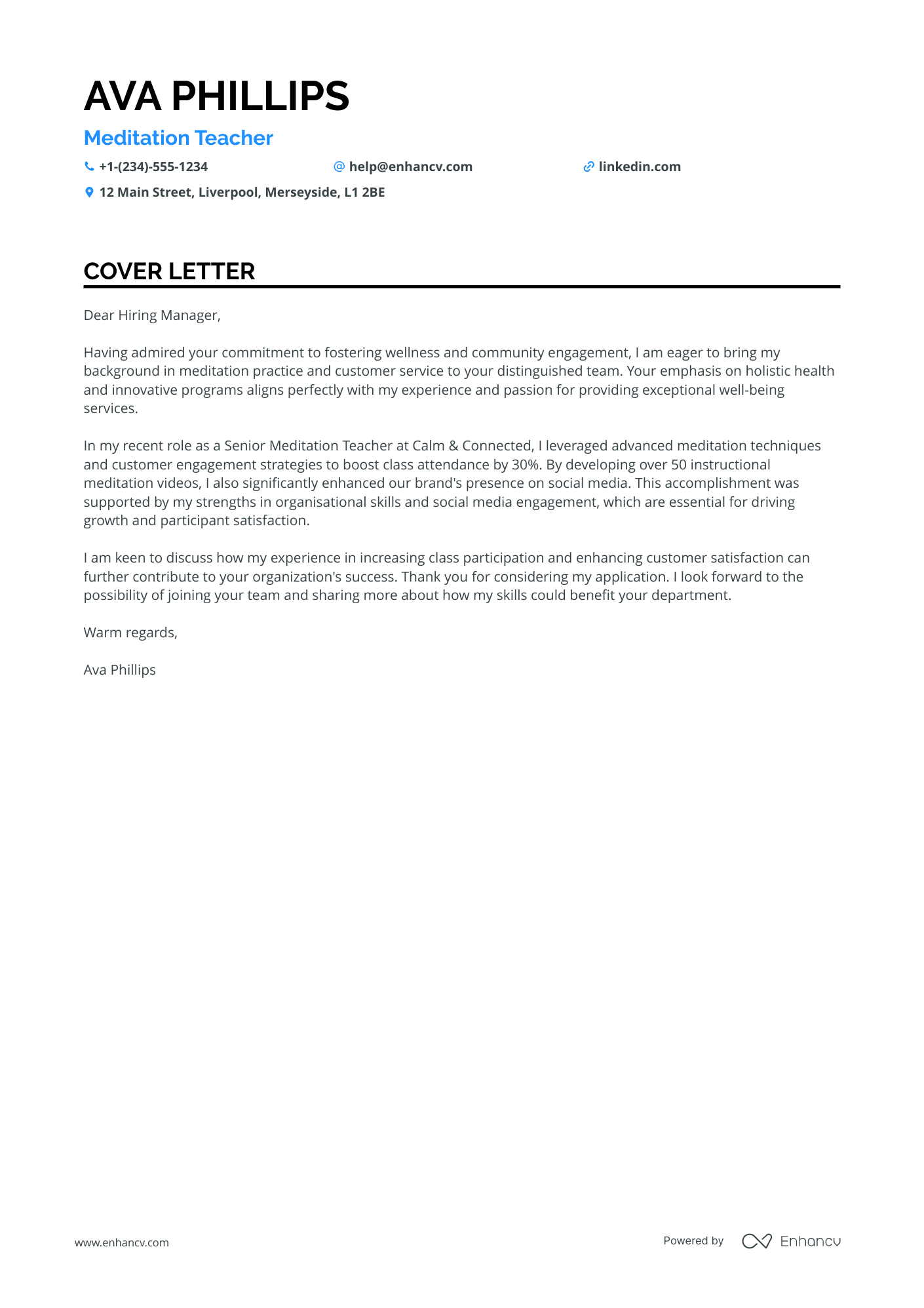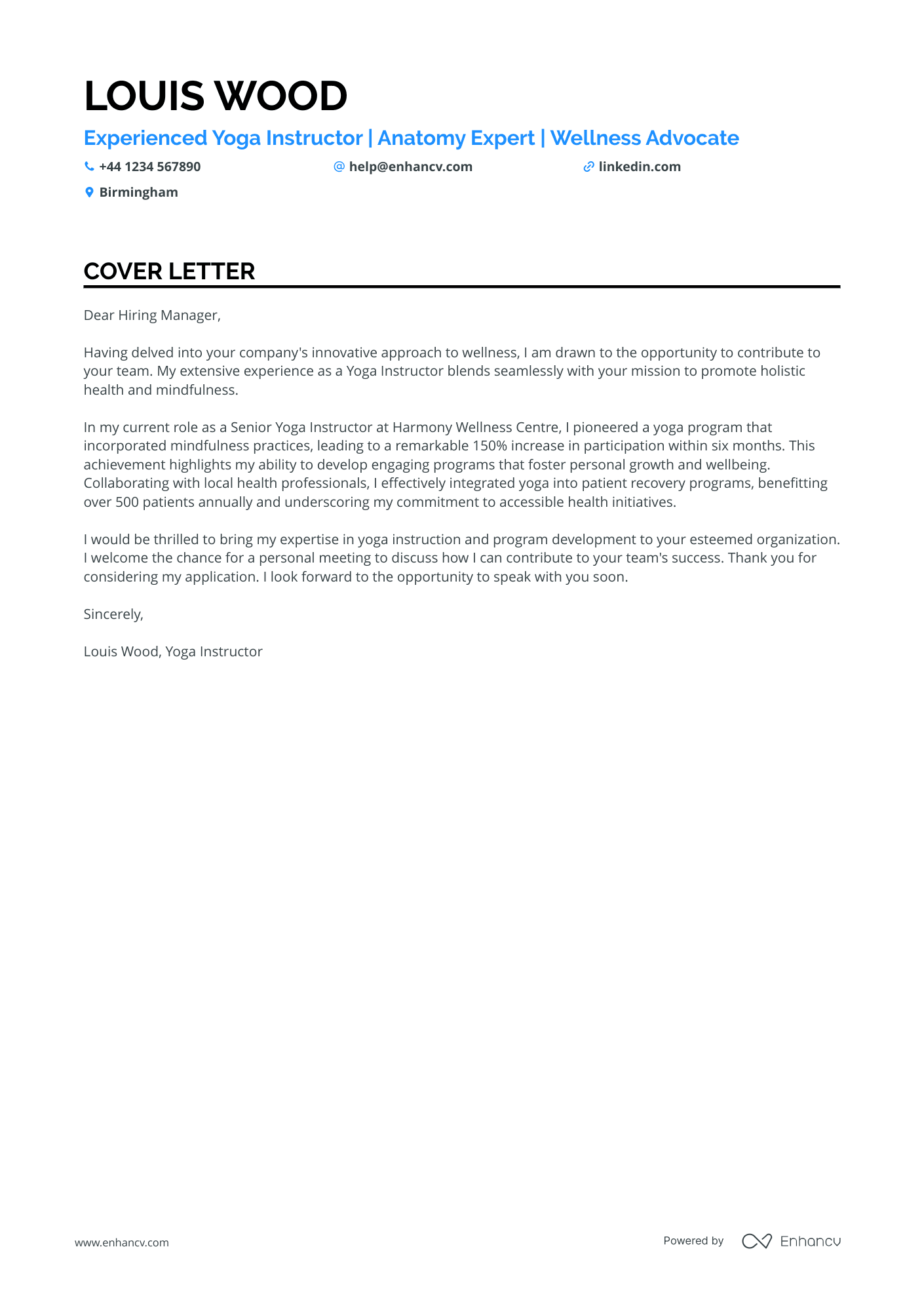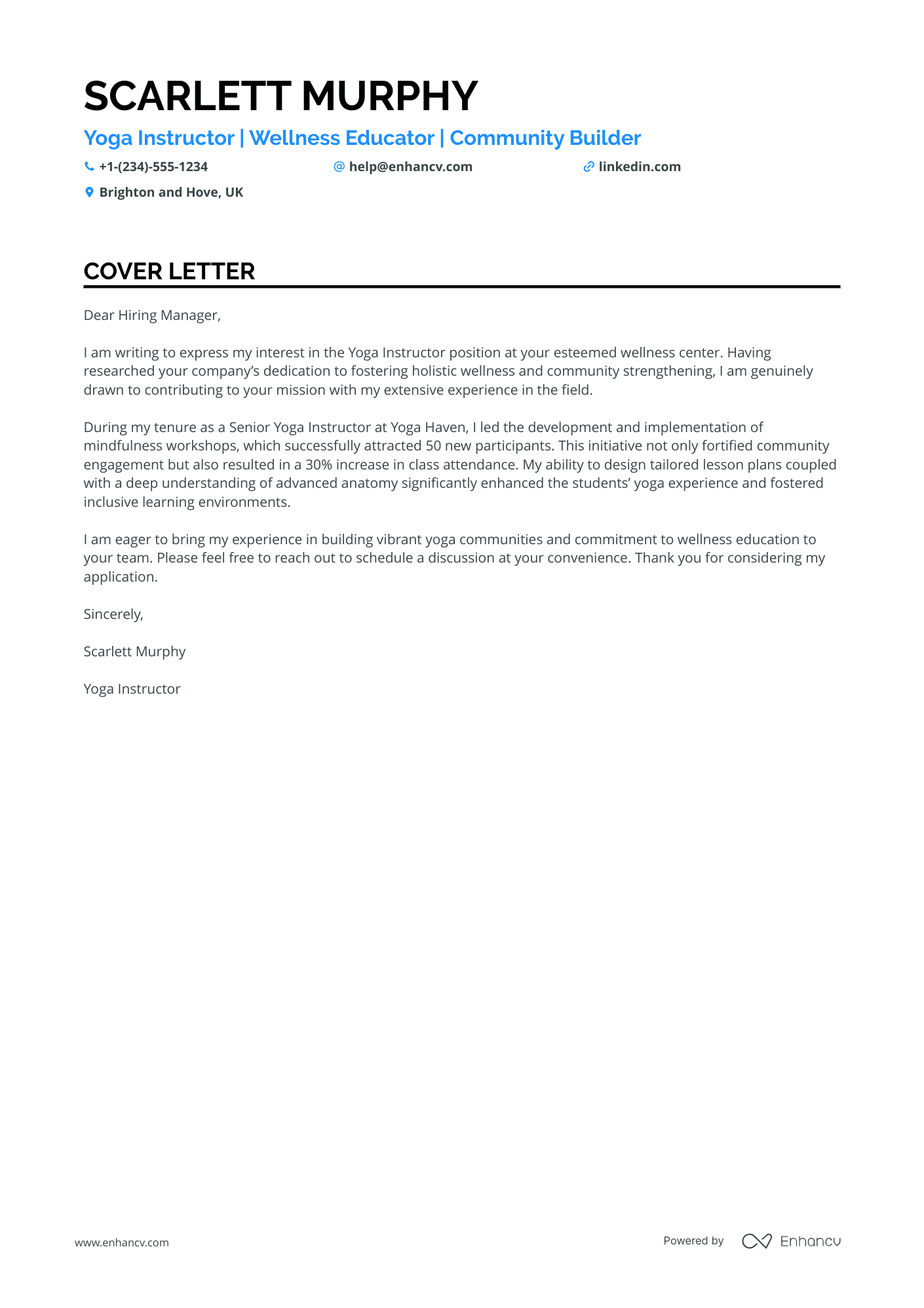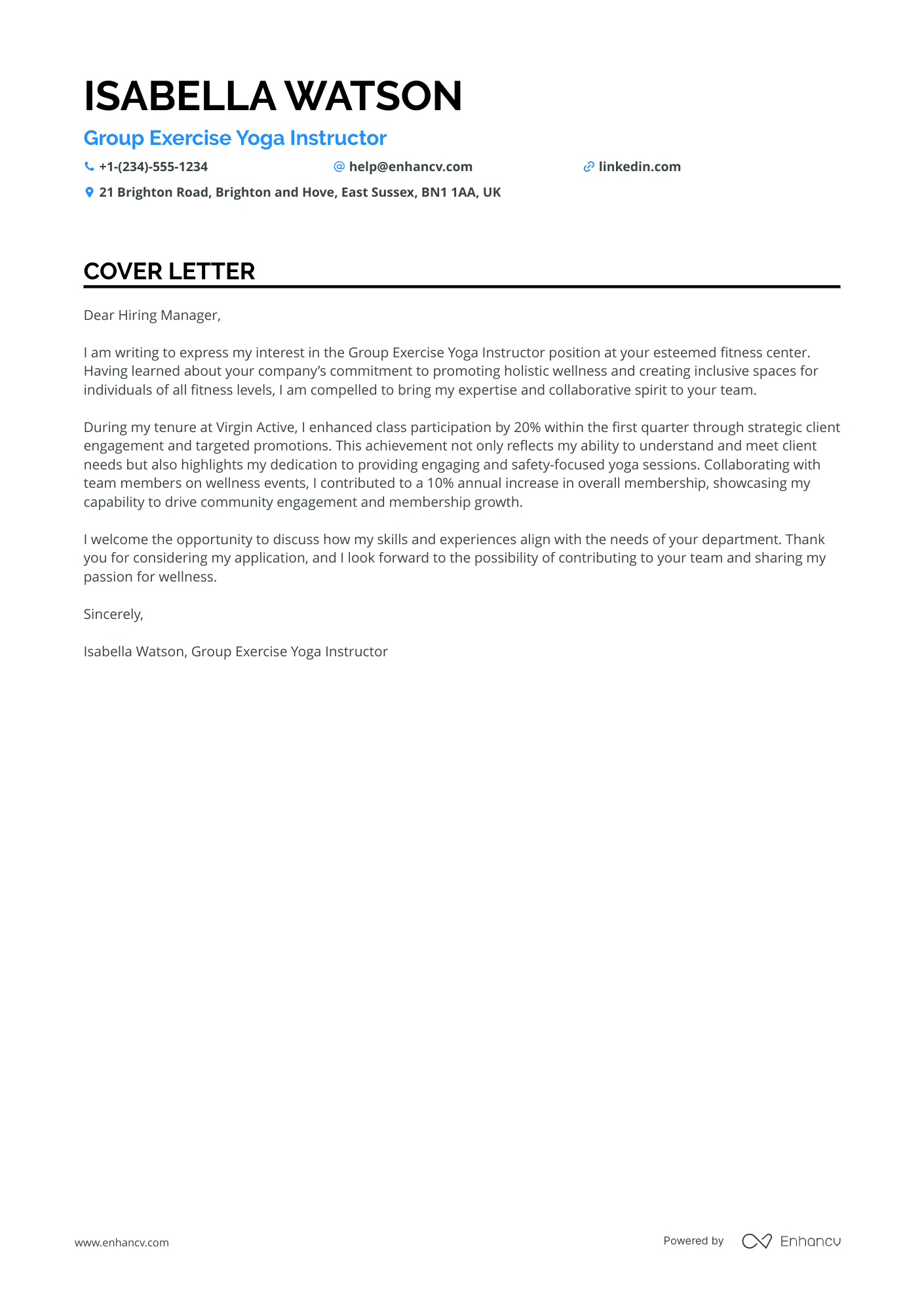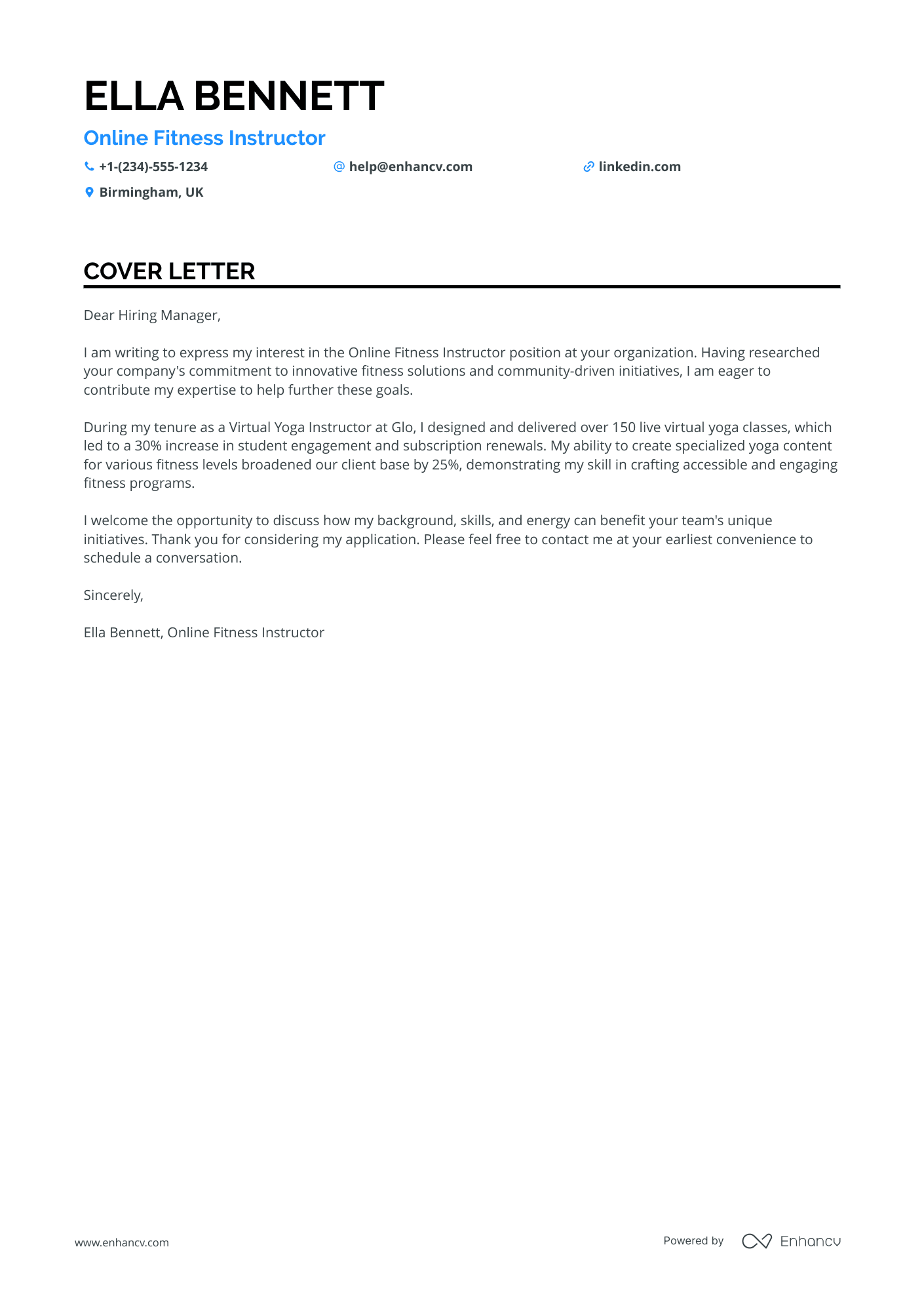When you start applying for jobs, you quickly realise that including a cover letter with your CV is a excellent way to stand out. But what should your cover letter focus on?
Should it emphasise your key achievements or simply list your responsibilities? And how can you effectively demonstrate that you're the ideal fit for the role?
One of the most common mistakes candidates make is either underselling themselves or overstating their experience.
In this guide, you’ll learn how to craft a compelling cover letter by showcasing your most significant professional achievement and telling the story behind it.
Cover letter examples for yoga teacher
By Experience
Senior Yoga Teacher
- Highlighting Specific Achievements: Emphasising a 30% increase in client retention through customer feedback mechanisms and a 25% increase in client base by expanding therapeutic techniques demonstrates the candidate's effectiveness and innovative approach.
- Relevance of Education and Certifications: Mentioning a Master of Science in Sports Therapy and certification in Advanced Deep Tissue Techniques underlines the technical expertise necessary for the role, enhancing credibility.
- Emphasis on Diverse Experience: The candidate's experience in conducting yoga workshops in corporate settings and therapeutic services for athletes illustrates adaptability and the ability to cater to varied client needs.
- Strong Client Relationship Management: Demonstrating skills such as maintaining a 100% appointment attendance rate and a high client satisfaction score speaks to excellent organisational and interpersonal skills that are critical for success in therapy roles.
Advanced Yoga Teacher
- Emphasising the "Advanced Yoga Teacher Training" certification by Yoga Alliance demonstrates specialised expertise in yoga instruction, crucial for showcasing advanced teaching techniques and class management skills.
- Highlighting a "Master of Science in Sport and Exercise Science" degree underlines a solid educational background, providing credibility in understanding advanced exercise science concepts necessary for a fitness role.
- The achievement of increasing participant retention by 20% signifies effective student engagement, showcasing an ability to personalise sessions and successfully meet individual fitness goals.
- Highlighting a reduction in class-related injuries by 30% demonstrates commitment to safety and effective risk management, important qualities for maintaining trust and ensuring participant wellbeing.
By Role
Yoga Teacher for Children
- Specialised Skills & Experience: Highlighting experience with increasing student engagement and satisfaction, particularly with a 15% improvement, tailored to dance and acrobatics instruction for children, aligns well with a role focused on enhancing child development through creative arts.
- Demonstrated Leadership & Innovation: Showcasing leadership in developing new curricula and training workshops for other teachers enhances the applicant's appeal for positions requiring initiative and the ability to enhance team performance.
- Significant Achievements: Mentioning specific achievements such as the "Teacher of the Year Award" for exceptional teaching quality underlines the candidate's proven track record and professional recognition in the field of dance education and child engagement.
- Diverse Educational Background & Additional Training: Emphasising advanced courses like "Advanced Dance Teaching Techniques" and "Children’s Yoga and Mindfulness" indicates a commitment to personal and professional growth, essential for roles in child education and arts.
Yoga Therapy Teacher
- Emphasising experience in anatomy and breath control, which is critical for a Yoga Instructor role, assures that the candidate has in-depth knowledge and expertise relevant to advanced yoga teaching.
- Highlighting the 30% increase in class attendance and 20% rise in satisfaction at previous jobs showcases the candidate's effectiveness in enhancing engagement and retaining students, key metrics for success in the role.
- Mentioning specific achievements such as the success of mindfulness workshops and client satisfaction milestones demonstrates the candidate's ability to initiate and successfully implement programs that build community and foster wellbeing.
- Including the titles of relevant courses like "Advanced Anatomy for Yoga" and "Mindfulness in Yoga Practice" reinforces the candidate's commitment to professional development in speciality areas important for a Yoga Instructor.
Hot Yoga Teacher
- Highlight any certifications or specialised training relevant to meditation and yoga instruction, such as the "Advanced Meditation Techniques" course or the "Yoga & Mindfulness for Well-being" certification.
- Emphasise experience in boosting attendance and enhancing community engagement, as demonstrated by the 30% increase in class attendance and the development of robust social media campaigns.
- Mention leadership roles and the impact made, like spearheading meditation retreats and training new instructors, which underline strong organisational and leadership abilities.
- Incorporate proficiency in social media engagement and programme development, both of which are vital in growing brand presence and customer interaction in wellness roles.
Yoga Teacher for Seniors
- Highlight Relevant Experience: The cover letter effectively emphasises Lucas's extensive experience in yoga and physical education, showcasing their progression from a Fitness Instructor to a Yoga Instructor.
- Showcase Certifications: Mentioning the "Advanced Yoga for Children" certification highlights their specialised skills, which are critical for a role that focuses on yoga instruction for young students.
- Quantify Achievements: Lucas's achievements are backed by quantitative data, such as a 40% improvement in student flexibility and a 30% increase in class participation, adding credibility to their impact and effectiveness as an educator.
- Emphasise Collaborative Skills: The cover letter details Lucas’s collaborative work with school staff and other instructors to tailor programs and develop cross-disciplinary activities, highlighting their ability to work well in team settings.
Prenatal Yoga Teacher
- Highlight Specific Certifications: Mentioning certifications in Pilates, Yoga, and fitness reinforces the applicant’s specialised expertise, which is crucial for establishing credibility and competency in fitness instruction.
- Emphasise Achievements in Client Engagement: Showcasing specific achievements such as a 75% increase in class attendance or a 60% boost in client retention effectively demonstrates success in maintaining and growing client base.
- Detail Experience with Injury Management: Including experience with injury rehabilitation protocols and workshops on injury prevention signals a comprehensive approach to client safety and wellness, a valued skill set in Pilates instruction.
- Showcase Workshop and Mentorship Roles: Mentioning workshop facilitation and mentorship of junior instructors highlights leadership and the ability to contribute to professional development, both critical for a leading instructor position.
Yoga Teacher for Athletes
- Highlighting Specific Achievements: Clearly mention quantifiable achievements such as "increased team success rates by 35%" to demonstrate the impact of your contributions.
- Tailoring Skills to the Role: Emphasise skills directly related to the role like "Sports Talent Evaluation" and "Athlete Development Planning," showcasing suitability for a sports evaluator position.
- Use of Professional Background: The inclusion of past roles and accomplishments in talent scouting and performance coaching positions strengthens credibility and establishes industry experience.
- Emphasising Relevant Certifications and Courses: Mentioning courses like "Advanced Performance Analytics" highlights a commitment to ongoing professional development in sports evaluation.
Yoga Teacher for Beginners
- Highlighting certifications such as the Advanced Yoga Teacher Training and Mindfulness-Based Stress Reduction Certification demonstrates specialised skills in advanced yoga techniques and stress management, crucial for a role focusing on well-being.
- Emphasising experience in increasing participant engagement and satisfaction showcases an ability to create inclusive environments and effectively increase participation, valuable in community-focused roles.
- Noting collaboration with healthcare providers and community centres highlights a strong commitment to accessibility and community engagement, key components of a Yoga Teacher's responsibilities.
- Showcasing achievements such as raising significant funds for mental health charities through yoga events supports a dedication to community welfare and the ability to use yoga for positive social impact.
Yoga Teacher for Disabled Individuals
- Certifications and Education: Highlight the "Advanced Yoga Teaching Certification" and relevant degrees like "Master of Science in Exercise and Sport Science" and "Bachelor of Arts in Physical Education" to underscore a strong educational background which is crucial for a Yoga Instructor role.
- Quantifiable Achievements: Emphasise specific outcomes such as a 20% increase in class attendance and 30% improvement in class retention, which provide tangible evidence of the candidate's impact in previous roles.
- Diverse Skill Set: Highlight skills like "Yoga Instruction," "Safety Regulations," and "Wellness Programmes," showcasing a comprehensive capability set that aligns with holistic health and wellbeing advocacy.
- Community and Client Engagement: Point out successful initiatives like the "Community Outreach Champion" and the implementation of feedback mechanisms, demonstrating the ability to foster community and improve client satisfaction.
Corporate Yoga Teacher
- Highlight Key Achievements: Emphasising specific achievements such as a 20% increase in student assessment scores or the successful implementation of a digital learning initiative showcases measurable success and expertise in the role.
- Showcase Relevant Experience: Detailing previous roles across various schools with clear descriptions of responsibilities and outcomes demonstrates a breadth of experience in different educational settings.
- Incorporate Professional Development: Highlighting ongoing professional development, such as courses on advanced KS1 strategies or inclusive classroom practices, reflects a commitment to continuous learning and adaptation in teaching methods.
- Emphasise Skills and Competencies: Identifying key skills such as curriculum development, classroom management, and engagement strategies focuses on relevant competencies for the KS1 Teacher role.
Yoga Teacher for Veterans
- Relevant Experience Highlighted: The cover letter effectively showcases over 7 years of experience in online teaching, specifically targeting children and teens, making it well-suited for an educational role.
- Quantifiable Achievements: The use of specific statistics such as increasing student enrolment by 25% and satisfaction by 30% adds credibility and demonstrates the candidate's impact in previous roles.
- Educational Credentials: Highlighting a Master of Education in Educational Technology supports the candidate’s expertise in the use of technology for education, a critical skill for an online educator.
- Specialised Courses and Certifications: Mentioning courses like "Advanced Techniques in Online Teaching" shows a commitment to continuous learning and staying current with educational technologies.
Yoga Teacher for Mental Health
- Highlight Relevant Experience: Describe past roles such as 'Yoga Flow Designer' and 'Yoga Content Writer' to demonstrate expertise in vinyasa flow design and content creation, which are key aspects of the role.
- Showcase Certifications: Include certifications such as the 'RYT 200-hour Certification', emphasising specialised training in vinyasa yoga and aligning well with the position's requirements.
- Emphasise Achievements: Mention awards like the 'App Content Enhancement Award' to illustrate a proven record of increasing user engagement, showcasing success in integrating technical skill with creativity.
- Link Skills to Outcomes: Clearly connect skills such as 'User Engagement' and 'Client Feedback Integration' to measurable outcomes like a 30% increase in user engagement, underscoring the impact of specific capabilities.
Yoga Teacher for Rehabilitation
- Customised Experience: The cover letter showcases Oliver's extensive experience in online education, emphasising his role in developing and delivering virtual classes with a high approval rating. Highlighting such tailored experience boosts his candidacy for roles requiring expertise in online teaching environments.
- Quantifiable Achievements: Oliver effectively uses quantifiable achievements such as a 40% increase in student engagement and a 25% improvement in individual performance, offering specific evidence of his impact and skills, which can differentiate him from other candidates.
- Relevant Certifications: Mention of courses such as 'Advanced Online Teaching Strategies' signals continuous learning and relevant expertise, ensuring employers recognise his commitment to staying updated in digital education trends, which is crucial for this role.
- Passion and Innovation: The inclusion of passions such as 'Digital Education Innovation' and achievements like the 'Innovation in Teaching Award' aligns with the role's needs for innovative approaches, underscoring Oliver's dedication to forward-thinking teaching solutions.
Yoga Teacher for Weight Loss
- Highlight Relevant Experience: The cover letter effectively showcases Ella’s experience as a Virtual Yoga Instructor and Wellness Coach, emphasising her proficiency in virtual class delivery and online engagement, which are crucial skills for the role.
- Emphasise Certifications and Education: Mentioning the Certified Yoga Teacher Training and her educational background in Sports and Exercise Nutrition adds credibility and illustrates her specialised knowledge in fitness and wellness.
- Quantify Achievements: Using specific metrics, such as a 30% increase in student engagement and a 40% growth in follower numbers, makes her achievements tangible and demonstrates her impact effectively.
- Incorporate Passion and Personal Impact: Including passions like Holistic Wellness and Sustainable Living adds a personalised touch that aligns with wellness advocacy, a significant aspect of the role.
Yoga Teacher for Stress Management
- Highlight specialised certifications: Emphasising certifications such as "Mindfulness-Based Stress Reduction" and "Advanced Cognitive Behavioural Therapy" to showcase specialised skills relevant to mental health coaching and therapeutic interventions.
- Detail measurable outcomes: Focusing on specific accomplishments like increasing client retention by 40% and reducing dropout rates by 20%, which clearly illustrate impact and effectiveness in previous roles.
- Showcase role progression and leadership: Documenting career growth from roles like Therapeutic Counsellor to Senior Mental Health Coach, highlighting leadership in expanding programmes and conducting workshops.
- Integrate passions with professional goals: Connecting passions such as "Technology Integration in Therapy" with professional achievements, demonstrating a forward-thinking approach to modern therapeutic practices.
Yoga Teacher for Dancers
- Certification Emphasis: Highlighting specific certifications such as the Advanced Yoga Teaching Certification and Pilates Advanced Instructor Course can demonstrate advanced skills and expertise relevant to the role.
- Experience with Results: Mentioning quantifiable achievements, such as increasing client retention by 40% and maintaining a 95% satisfaction rate in virtual classes, showcases successful outcomes and effectiveness in past roles.
- Skills in Virtual Class Facilitation: Emphasising experience in delivering over 300 virtual classes can highlight proficiency in remote instruction, a vital skill for the role.
- Language Proficiency: Noting proficiency in English and intermediate-level Spanish can indicate an ability to communicate with a broader range of clients, reinforcing adaptability and communication skills.
Yoga Teacher for Cancer Patients
- Highlighting Relevant Experience: The cover letter effectively showcases Matilda's extensive experience as an online instructor and e-learning coordinator, emphasising her ability to develop engaging digital learning experiences.
- Specific Achievements: It details measurable improvements in student engagement and outcomes through customised lessons and interactive materials, underscoring Matilda's impact in the field.
- Certifications and Education: The mention of certifications in online teaching and instructional design reinforces Matilda's commitment to continuous professional development, a vital trait for evolving educational practices.
- Passion for the Role: Matilda's passion for educational technology and creative writing highlights her enthusiasm and diversifies her skills, signalling a well-rounded candidate devoted to enhancing learning experiences.
Yoga Teacher for Pregnant Women
- The cover letter effectively highlights specialised certifications such as the "Certified Health Coach" and "Mind-Body Medicine Training", which are highly relevant for a role focused on wellness and holistic health.
- It emphasises experience in "Chronic Illness Coaching" and "Health Coaching", reinforcing the applicant's expertise in the specific role they are pursuing.
- The cover letter showcases significant achievements like increasing client satisfaction by 45% and improving dietary habits by 60%, demonstrating impactful experience that directly aligns with the job description.
- Skills like "Mind-Body Integration" and "Nutritional Planning" are prominently mentioned, which are essential for a Wellness Expert role, further establishing the applicant's qualifications.
Yoga Teacher for Postnatal Recovery
- Highlight Relevant Experience: The cover letter effectively highlights over 5 years of experience in online education, making it clear that the candidate has a solid background in virtual instruction.
- Emphasise Achievements in Student Engagement: Emphasising achievements such as a 30% increase in student engagement and satisfaction through innovative teaching methods demonstrates effectiveness in engaging learners.
- Showcase Technical Proficiency: Mentioning proficiency in educational technology and online tools showcases the candidate's ability to leverage technology for enhanced learning experiences.
- Include Recognitions and Awards: Listing recognitions such as "Excellence in Online Education" underlines credibility and expertise in delivering high-quality online learning.
Yoga Teacher cover letter example
Louis Wood
Birmingham
+44 1234 567890
help@enhancv.com
- Highlighting Relevant Experience: Emphasize past roles where you have demonstrated similar skills or responsibilities, such as program development or increasing participation in wellness activities.
- Specific Achievements: Provide quantifiable achievements that showcase your expertise and effectiveness, like the 150% increase in participation for the yoga program.
- Collaborative Initiatives: Mention collaborations with other healthcare professionals to demonstrate your ability to work in a team and contribute to broader health goals.
- Alignment with Company Mission: Express genuine interest and alignment with the company's mission to promote holistic health, showing that your values are in sync with the organization.
Importance of cover letters in the United Kingdom
Cover letters provide recruiters with the opportunity to learn more about your career aspirations, hinting at how you’d integrate within the organisation over the long term.
Here are three additional reasons why cover letters are important:
- Making an excellent first impression (and a formal introduction): Your cover letter is often the employer’s first introduction to you, showcasing your personality, communication skills, and motivation for the role.
- Complementing your career history: While your CV lists qualifications and experience, a cover letter provides the context, explaining how your background fits the role.
- Demonstrates your genuine interest: A well-crafted cover letter reflects the effort you’ve put into researching the company and role as well as your attention to detail.
What UK employers expect from a cover letter
A great cover letter can set you apart when applying for jobs in the UK.
Follow these tips to ensure you make a strong impression:
- Research thoroughly: Spend time delving into the company’s website, social media, and industry news to understand their projects, awards, and future plans. The more specific your knowledge, the better you’ll be able to demonstrate your suitability for the role.
- Reflect their values: Every UK company has its own set of values that guides their culture. Once you’ve identified them, make sure your cover letter reflects how your values and work ethic align with theirs. If they’re known for integrity, emphasise your commitment to ethical practices.
- Tailor your skills: Focus on aligning your most relevant skills with the job description. Look for key terms and priorities mentioned in the advert, and make sure to provide examples of how you excel in those areas.
How to format a yoga teacher cover letter
Your cover letter is your opportunity to make a strong impression, so its structure must be professional and clear.
Here's an overview of how a UK cover letter should be structured:
- Begin with your address and contact details at the top.
- Include the employer’s name and address directly below.
- Add the date to the left or right of the page.
- Use an appropriate greeting, such as 'Dear Mr Smith' or 'Dear Sir/Madam.'
- Open with a strong introductory paragraph.
- Develop your points in the middle paragraphs, focusing on relevant skills and experience.
- Close with a concise conclusion, reiterating your interest and suitability for the role.
- Sign off formally with your name and signature.
The software used to match your profile to the job, Applicant Tracking Systems (ATS), won’t scan your cover letter. Instead, the cover letter reads as a more personalised note to the recruiter.
When it comes to choosing a font, consider modern options like Lato, Rubik, or Chivo, which should also be applied to your CV to maintain a consistent appearance.
Additionally, your cover letter should be single-spaced with 1-inch (2.5 cm) margins on all sides (our templates are pre-set with these specifications so you can focus on your cover letter content).
Finally, always send your cover letter as a PDF to preserve the formatting and prevent edits.
How to write your yoga teacher cover letter salutation
Imagine you're a hiring manager reading through countless cover letters—which would catch your attention: being addressed directly by name, or reading 'Dear Sir or Madam'?
The first option shows you've made the effort to learn about the company and the role.
To find the hiring manager's name, try LinkedIn, check the company's website, or even reach out to the organisation on social media.
How to write your yoga teacher cover letter intro
A great option to begin your cover letter is by showing recruiters you've done your homework or research.
If the company has won an award or made headlines, congratulate them in your opening sentence, or express how impressed you are.
Provide this achievement as a reason why you admire the company, ensuring your tone remains genuine, sincere, and authentic.
How to write your yoga teacher cover letter body
A well-written cover letter body goes beyond the content of your CV, expanding on your greatest achievement to form your compelling case.
The narrative you tell within it could focus on a few key elements:
- A concrete and noteworthy achievement: Backed by data and relevant to the job.
- Your hard and soft skills: Presented with measurable outcomes and results.
- A successful project: Showing how you contributed to the final result.
The goal is to tell a story that aligns with the company’s needs and adds a more human touch to your application.
How to write a closing paragraph
Now we’ve reached the closing paragraph of your cover letter. You might be tempted to end with a simple Yours sincerely, but don’t!
Instead, finish with a promise to enhance the company’s performance metrics (backed by your hard and soft skills), to develop as a professional, or something else that holds significance for the organisation. Whatever you choose, ensure to stand behind your words and be remain sincere.
Don’t forget to include a call to action, encouraging recruiters to suggest the best time to follow up for an interview or update.
Conclusion
Creating a compelling cover letter is vital in making a positive first impression on potential employers. Personalise your letter by addressing the hiring manager directly and ensuring your skills align with the job description.
Highlight specific achievements that demonstrate your suitability for the role, and express genuine enthusiasm for the opportunity. Finally, maintain a professional format that complements your CV for a cohesive application.




